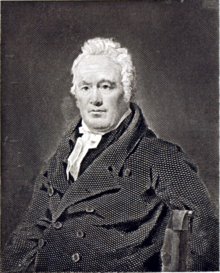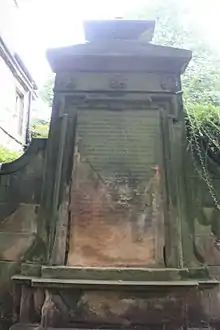George Paxton (minister)
George Paxton (2 April 1762 – 9 April 1837) was a Scottish secession minister and poet. He was professor of divinity at the University of Edinburgh.[1]
George Paxton | |
|---|---|
 | |
| Personal details | |
| Born | 2 April 1762 Bolton |
| Died | 9 April 1837 Edinburgh |
| Buried | West Kirk |
Life


Background
Paxton was born on 2 April 1762 at Dalgourie, on the edge of Bolton, East Lothian. He was the eldest son of Jean Milne and William Paxton a joiner and carpenter. In early childhood he moved with his family to Melrose, then again to Makerstoun, near Kelso. Here a local laird, Sir Hay McDougal, a colonel in the Scots Greys, took Paxton under his wing.
Education
Sir Hay sent George to Kelso to learn Latin and Greek. After an unfinished apprenticeship as a carpenter, he left his home town to attend the University of Edinburgh but left in 1784 without a degree. He continued his education with the private tutor Reverend William Moncrieff in Alloa. Here he became "a firm seceder".[2]
Ordination and secession
In March 1788 George received his licence to preach and was ordained as minister of the joint parishes of Kilmaurs and Stewarton in August 1789, choosing to live in the latter village. Owing to ill-health, around 1800, he was forced to abandon this job, and take a 7-year respite. However, the synod thereafter appointed him as professor of divinity. In 1820 he had a dispute with Reverend Thomas McCrie, and was forced to resign his professorship. He then set up his own independent secession church, in an old chapel on the steps of the Vennel, in a hidden location off the Grassmarket in Edinburgh. In 1822 he commissioned Thomas Brown to build a new church on Infirmary Street, just off South Bridge.[3] Together with a split-off group from Reverend McCrie they formed the Associate Synod of Original Seceders. He was then invited to resume his professorship acting for this new body. In 1828 he is shown as a member of the Edinburgh Bible Society under the leadership of Lord Glenorchy.[4]
In the 1830s he is listed as living at 12 Archibald Place, off Lauriston Place, near to George Heriot’s School on the south side of Edinburgh.[5]
Death and memorial
George Paxton died in Edinburgh on 9 April 1837 and is buried in the "West Kirk" burial ground, generally now known as St Cuthbert’s Churchyard. The tall monument is eroding and the lower text is lost... it stands against the south wall.
Family
Paxton married Elizabeth Armstrong of Kelso in 1790. Their marriage was cut short by her death in 1800. Together they had two sons and three daughters.
His daughter, Jean, married the Reverend John More of Cairneyhill in Fife.[6]
His son, George, became a doctor and rose to fame in India.
Paxton married a second time, to Margaret Johnstone, daughter of a Berwick farmer.
Publications
- An Inquiry into the Obligation of Religious Covenants upon Posterity (1801)
- Healing the Divisions in our Church (1802)
- The Villager and other Poems (1813)
- Illustrations of the Holy Scriptures 3 vols (1822)[7]
References
- Shaw, William Arthur (1895). "Paxton, George". In Lee, Sidney (ed.). Dictionary of National Biography. 44. London: Smith, Elder & Co.
 This article incorporates text from this source, which is in the public domain.
This article incorporates text from this source, which is in the public domain. - Oxford Dictionary of National Biography: George Paxton
- City of Edinburgh Council: Listed Building records
- The Edinburgh Almanack, Or Universal Scots and Imperial Register, ... Oliver & Boyd. 1828.
- "Edinburgh Post Office annual directory, 1832-1833". National Library of Scotland. Retrieved 19 January 2018.
- "Reverend John More". www.genealogy.com. Retrieved 19 January 2018.
- The Christian Spectator. Howe & Spalding. 1822.